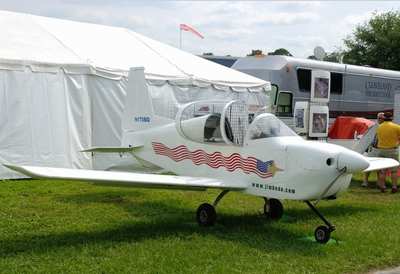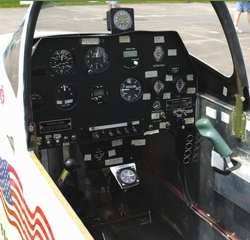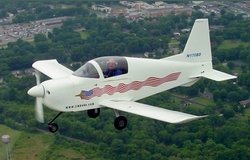Five Kits Under Construction, Prop Needs Final Adjustments
By ANN Correspondent Juan Jimenez
The BD-17 Nugget, a single-seat sport plane designed by Jim
Bede, is now being built by five customers. Two of them are
building their aircraft in Florida, two are in Ohio and one of them
is in Texas.

Test pilot Corkey Fornof is also in the process of completing
the flight testing of the prototype aircraft with the latest
modifications. Most of the work is done, and they are now working
on testing different propellers to determine the optimum
configuration.
According to Fornof, the aircraft is "running like a charm and
is too much fun. The cabin is so big that I need cushions." One
thing that did stand out to this reporter is how quiet the aircraft
was as Fornof put it through its paces in the pattern and over the
flight line at Lakeland. "The aircraft is indeed quiet inside as
well, and it is also very 'stealthy'. I definitely recommend the
installation of a transponder so TCAS on larger aircraft can see
it, and strobes."
 One
thing most people who are interested in the aircraft want to know
is if the flight tests are confirming Jim Bede's performance
figures for the design. Fornof says that the numbers are right on
the money. At full power (6100 RPM) with no wheel pants and what is
still not the right prop, the aircraft is reaching 150 mph IAS on 3
gph. At cruise power of 5600 RPM, IAS is 135 mph on 2.5 gph fuel
consumption, a very impressive performance.
One
thing most people who are interested in the aircraft want to know
is if the flight tests are confirming Jim Bede's performance
figures for the design. Fornof says that the numbers are right on
the money. At full power (6100 RPM) with no wheel pants and what is
still not the right prop, the aircraft is reaching 150 mph IAS on 3
gph. At cruise power of 5600 RPM, IAS is 135 mph on 2.5 gph fuel
consumption, a very impressive performance.
Fornof reports that the Nugget has great rudder response - at as
little as 5 or 6 mph he can steer on the ground with the rudder
instead of the brakes. "How's that for rudder authority?" he
quipped. On takeoff, the Nugget starts to get light at 50 mph. He
usually rotates it at 70 mph - anything less and he says the pilot
will have to hold attitude in ground effect before trying to climb.
He then stabilizes the climb at 85 mph, achieving slightly over 800
fpm. Once the right propeller is found, he expects all the numbers
to improve slightly.
The aircraft stalls at 55 mph dirty. However, 10 to 12 mph
before he reaches that it shows clear signs of sinking, which is
instantly resolved through application of power. Full control
authority is retained before, through and after the stall. The
controls are all nicely balanced on all axes, and the airplane is
"sweet to fly," says Fornof.
Fornof added that he's found that best L/D is achieved at 90 mph
- anything higher and the little bird just does not seem to want to
head back to the roost. It is very easy to set up a stabilized
approach by selecting two notches of flaps and slightly reducing
power to 4600 RPM or so. Hold the attitude and speed all the way
down to the numbers and slowly cut power after passing the runway
threshold to have the aircraft gently settle into the runway.
Without even trying, Fornof says he is getting 600 to 700 foot
landing rolls after touching down at 65 to 70 mph.
 The
only airframe changes done since the last time we reported on the
Nugget's progress are some minor cowling changes and the fact that
Lopresti is now manufacturing the wing panels. This reporter tried
out the Nugget for size, and was able to easily and comfortably fit
all 70 inches and 235 pounds of ex-Marine into the spacious cabin,
with plenty of room to spare and at least 4 inches of headroom
under the canopy.
The
only airframe changes done since the last time we reported on the
Nugget's progress are some minor cowling changes and the fact that
Lopresti is now manufacturing the wing panels. This reporter tried
out the Nugget for size, and was able to easily and comfortably fit
all 70 inches and 235 pounds of ex-Marine into the spacious cabin,
with plenty of room to spare and at least 4 inches of headroom
under the canopy.
Could this be the winner that Jim Bede has been searching for so
long? This reporter is convinced that it is, but only time will
tell as kits are completed and begin to take to the air.
 ANN's Daily Aero-Linx (05.06.25)
ANN's Daily Aero-Linx (05.06.25) ANN's Daily Aero-Term (05.06.25): Ultrahigh Frequency (UHF)
ANN's Daily Aero-Term (05.06.25): Ultrahigh Frequency (UHF) ANN FAQ: Q&A 101
ANN FAQ: Q&A 101 Classic Aero-TV: Virtual Reality Painting--PPG Leverages Technology for Training
Classic Aero-TV: Virtual Reality Painting--PPG Leverages Technology for Training Airborne 05.02.25: Joby Crewed Milestone, Diamond Club, Canadian Pilot Insurance
Airborne 05.02.25: Joby Crewed Milestone, Diamond Club, Canadian Pilot Insurance





